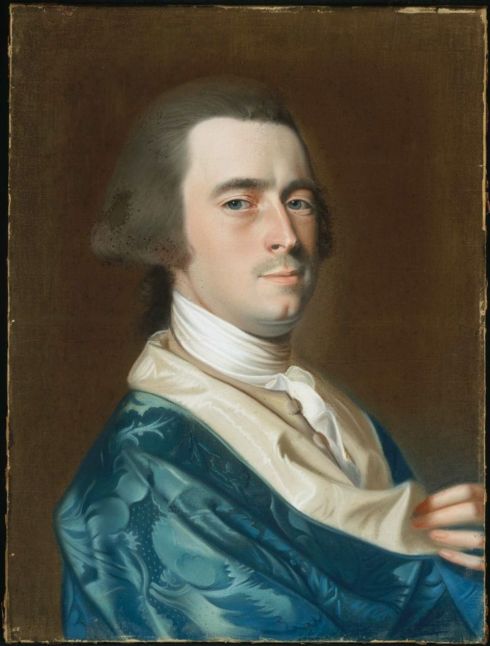The public presentation of history is often driven by anniversaries, and Britain is just beginning a long Georgian moment driven by the 300th anniversary of the Hanoverian dynasty’s accession in 1714 and commencing (after the birth of little Prince George this summer) with the British Library’s new exhibition Georgians Revealed: Life, Style and the Making of Modern Britain. Viewing it from afar (online), I like the exhibition’s emphasis on Georgians rather than the more boring King Georges, and its inclusion of some of the more interesting aspects of the era: the development of “celebrity culture”, the “commercialization of leisure”, the emergence of the novel, and intensifying consumerism in many realms of life. But from my own distant Anglo-American perspective, I’m noticing a distinct lack of a colonial presence. Before the Revolution, we should certainly consider the people who inhabited British America as Georgians, so I’m featuring a few of my favorite American Georgian gentlemen here. Although I don’t have quite the same connection to them that I do for some of the people of the earlier era in which I specialize, there is something compelling about both their images (personas) and their stories, if only because several of them walked on the same streets that I do.
My Georgian Gentlemen: Benjamin Pickman, the dashing Loyalist Salemite and husband of the faithful Mary of my last post. What better Georgian than a Loyalist? Even though he left his family and country, his letters testify to the earnestness of his decision and the pain he endured from the separation. Here John Singleton Copley pictures him as a young man, well before this rift, and I think he looks both dashing and earnest. Jonathan Jackson, a contemporary of Pickman’s from Newburyport, painted in his resplendent blue robe by Copley. Jackson looks a little more “Georgian” here but he was no Loyalist: he converted his merchant ships to privateering vessels during the Revolution and later served as a Massachusetts delegate to the Continental Congress. His first wife, Sarah Barnard Jackson, was the daughter of the Reverend Thomas Barnard of Salem, whose silhouette is below. As a true Georgian, Barnard helped avert what might have become the first clash of the American Revolution in early 1775–an incident called “Leslie’s Retreat”–when he negotiated British Colonel Alexander Leslie’s retreat from Salem.
John Singleton Copley, Benjamin Pickman, c. 1758-61, Yale University Art Gallery; John Singleton Copley, Jonathan Jackson, late 1760s, Museum of Fine Arts, Boston; Painted Silhouette of the Reverend Thomas Barnard of Salem, late 18th/early 19th century, Skinner’s Auctions.
Obviously I have a preference for Copley, who, like his colleague and compatriot Nathaniel West, represents the Anglo-American/Atlantic world in which the acclaimed artist lived and worked. Both were “American” artists who became “English” artists: they were true Georgians above all. Both left their “country” for good before the American Revolution, along with Henry Pelham, Copley’s stepbrother and the subject of one of his most famous compositions, A Boy with a Flying Squirrel (1765). My favorite illustration of this Anglo-American artistic world is a painting of West’s London studio by his protégé Matthew Pratt: entitled The American School, it hints at the future division.
John Singleton Copley, A Boy with a Flying Squirrel, 1765, Museum of Fine Arts, Boston; Matthew Pratt, The American School, 1765, Metropolitan Museum of Art.
It looks like Georgians Revealed depicts British Georgians as a fun-loving, pleasure-seeking people: there are lots of illustrations of drinking, dancing and dressing: by comparison, American Georgians look rather earnest and restrained. It’s hard to compete with the vibrant print culture that emerged in Britain from the 1780s on, however, just when Americans ceased being Georgians.
Carousing Georgians in Britain and Psalm-singing Georgians in America: Midnight. Tom and Jerry at a Coffee Shop near the Olympic, illustration by Issac and George Cruikshank in Pierce Egan, Life in London, 1823, British Library; Paul Revere, “the Music Party”, engraving for the frontspiece of William Billings, The New England Psalm-Book, Boston, 1770. Library of Congress.













December 5th, 2013 at 9:09 am
Shouldn’t it be the 400th anniversary of the Hanoverian dynasty, with George I ascending the throne in 1714? George III had already lost the colonies long before 1814!
December 5th, 2013 at 3:12 pm
No – but you’ve made a simple typo: it’s the 300th anniversary since 1714, not 1814.
December 6th, 2013 at 8:00 am
Thanks for catching my mistake–you two–not good for an historian! Early morning blogging…
December 7th, 2013 at 11:45 am
I can’t say I covered myself in glory either! Maths was never my strong point. By the way, fans of Georgian England might want to check out the newly renovated Kenwood House in North London. It’s gorgeous: http://www.dailymail.co.uk/news/article-2513611/Kenwood-House-houses-masterpieces-Rembrandt-Vermeer-set-reopen.html
December 7th, 2013 at 5:14 pm
Thanks for the link, Alastair–I saw this house long ago–looking forward to seeing it in its newly-renovated state.
December 5th, 2013 at 3:49 pm
Fascinating post, Donna! I’ve borrowed Mr. Barnard, as I live in Barnardsville (named for Job Barnard, whose store housed the first post office.
September 18th, 2015 at 6:02 am
[…] Streets of Salem, Museum of Fine Arts […]